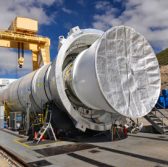 NASA engineers continue to analyze data collected from the second qualification test conducted on Orbital ATK-built booster for the Space Launch System to demonstrate the technology’s power and operations capacity.
NASA engineers continue to analyze data collected from the second qualification test conducted on Orbital ATK-built booster for the Space Launch System to demonstrate the technology’s power and operations capacity.
The assessment took place June 28 at Orbital ATK’s facility in Utah and aimed to evaluate the SLS booster against 82 qualification test objectives that were measured through more than 530 instrumentation channels on the booster at a 40-degree Fahrenheit cold motor conditioning target, NASA said Friday.
“We still have many months to go to analyze all the data from the second test, as it’s a very detailed process,” said Mat Bevill, NASA Marshall Space Flight Center SLS Booster office deputy chief engineer.
The space agency noted it works with Orbital ATK engineers to disassemble the 154-foot-long booster, conduct post-test measurements and compare data from four previous ground tests for design verification.
 SLS boosters will undergo a design certification review after NASA completes the test data analysis and before the agency moves the system to the launch pad.
SLS boosters will undergo a design certification review after NASA completes the test data analysis and before the agency moves the system to the launch pad.
“Booster flight hardware for our first flight, Exploration Mission-1, is in full production, with four segments being cast and a fifth going to casting later this month at Orbital ATK,” said Alex Priskos, manager of the SLS Boosters Office at NASA.
“We also have aft skirt refurbishment work taking place at Kennedy Space Center, where the boosters will be stacked ahead of the flight,” Priskos added.
The SLS is designed to carry approximately 77 tons of payload and will be powered by two five-segment boosters and four RS-25 main engines on deep-space missions.
A planned configuration update to the heavy-lift rocket seeks to increase its payload capacity to 115 tons.




